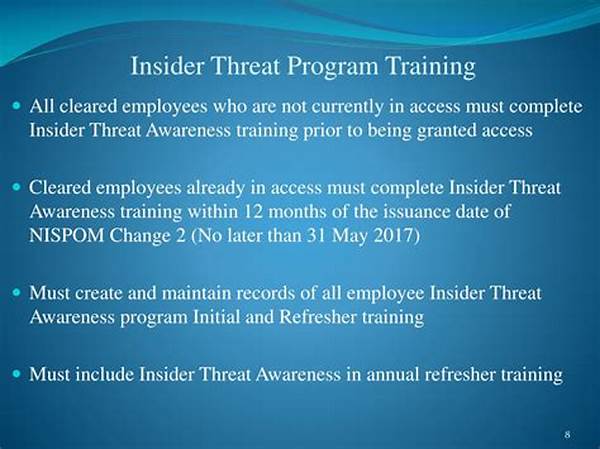In today’s complex digital landscape, organizations face an increasing number of security threats, not only from external sources but from internal actors as well. Insider threat awareness training programs have become a critical component in safeguarding sensitive information and maintaining the integrity of an organization’s operations. These programs are designed to educate employees on identifying, mitigating, and preventing potential risks posed by insiders who may intentionally or inadvertently compromise data security. Through a structured curriculum, participants gain the skills necessary to detect early warning signs of insider threats and implement appropriate countermeasures, ultimately fortifying the organization’s defenses against such incidents.
Importance of Insider Threat Awareness Training Programs
Insider threat awareness training programs are essential for fostering a culture of security and vigilance within an organization. They serve as a proactive measure to safeguard against the potentially devastating consequences of insider threats. By equipping employees with knowledge and strategies to recognize and address suspicious activities, organizations can significantly reduce the risk of data breaches and other security incidents. The training emphasizes the importance of reporting unusual behaviors and encourages open communication among team members. Moreover, these programs help in building a sense of responsibility and accountability among employees, ensuring that they remain vigilant in protecting sensitive information. As such, insider threat awareness training programs play a pivotal role in strengthening an organization’s overall security posture and promoting a secure working environment.
Key Components of Insider Threat Awareness Training Programs
1. Identification of Threat Indicators: Insider threat awareness training programs educate employees on various threat indicators, helping them recognize potential red flags that may suggest insider threat activities.
2. Risk Assessment Techniques: Participants are trained to conduct thorough risk assessments, evaluating potential vulnerabilities within the organization and implementing strategies to mitigate those risks.
3. Incident Response Protocols: The programs emphasize the importance of having well-defined incident response protocols, ensuring that employees know the appropriate actions to take in the event of a security breach.
4. Legal and Ethical Considerations: Insider threat awareness training programs address the legal and ethical implications of insider threats, ensuring that employees understand their obligations and responsibilities in maintaining data security.
5. Continuous Education and Refreshment: These programs stress the importance of ongoing education and refresher courses to keep employees informed about the latest threats and security practices.
Implementing Effective Insider Threat Awareness Training Programs
Effective insider threat awareness training programs require comprehensive planning and execution. Organizations should tailor these programs to address specific risks and vulnerabilities unique to their operations. By incorporating real-world scenarios and case studies, the training can provide a more practical understanding of potential threats and their consequences. Collaboration between different departments is crucial, enabling a multi-faceted approach to security that encompasses technical, behavioral, and procedural aspects. Additionally, these programs should be regularly updated to reflect the evolving threat landscape, ensuring that employees are equipped with the most current information and tools to combat insider threats. Ultimately, successful implementation of these programs can lead to a more resilient organizational structure and a significant reduction in the likelihood of insider-related incidents.
Challenges in Developing Insider Threat Awareness Training Programs
Developing insider threat awareness training programs poses several challenges, including ensuring the content’s relevance to various organizational roles and responsibilities. One key difficulty lies in maintaining engagement among participants, particularly when dealing with technical subject matter. To address this, training programs should employ diverse instructional methods, such as interactive workshops and e-learning modules, to cater to different learning preferences. Another challenge is measuring the training’s effectiveness, which can be achieved through regular assessments and feedback mechanisms. Organizations must also navigate the complexities of privacy concerns, ensuring that monitoring practices do not infringe upon employees’ rights while still safeguarding against insider threats. Despite these challenges, the benefits of well-designed training programs far outweigh the difficulties involved in their development and implementation.
Evaluating the Effectiveness of Insider Threat Awareness Training Programs
Insider threat awareness training programs must be regularly evaluated to ensure they remain effective and relevant. Metrics such as incident response times, the number of reported suspicious activities, and the reduction in security breaches can provide quantitative measures of the program’s impact. Employee surveys and feedback sessions offer qualitative insights, enabling organizations to refine their training content and delivery methods continually. By fostering a culture of continuous improvement, organizations can enhance the training’s effectiveness over time, ensuring that employees remain vigilant against evolving insider threats. Evaluating and updating these programs is critical to maintaining a robust defense against the ever-present risk of insider incidents.
Enhancing Employee Engagement in Insider Threat Awareness Training Programs
Engaging employees in insider threat awareness training programs is crucial for their success. Interactive elements, such as simulations and role-playing exercises, can boost participation and reinforce learning outcomes. Facilitating open discussions and encouraging questions also contribute to a more engaging training experience. To further enhance engagement, organizations may incorporate gamification techniques, such as quizzes and leaderboards, to foster a competitive yet collaborative learning environment. Recognizing employee achievements in the training can also motivate continued participation and application of the knowledge gained. By prioritizing engagement, organizations can ensure that the training programs are not only informative but also compelling and relevant to participants.
Conclusion
In conclusion, insider threat awareness training programs are indispensable in today’s security-conscious world. These programs provide the necessary framework for educating employees about the critical role they play in safeguarding organizational assets. By understanding and recognizing the signs of potential insider threats, employees become integral components of the organization’s defense strategy. The ongoing refinement and evaluation of these programs ensure their continued effectiveness in mitigating risks and maintaining a culture of security. As organizations face increasingly sophisticated threats, insider threat awareness training programs remain a foundational element in the protection against internal and external dangers. The collective knowledge and vigilance of an organization’s workforce are pivotal in building resilience and fortifying defenses against the ever-present risks posed by insider threats.





